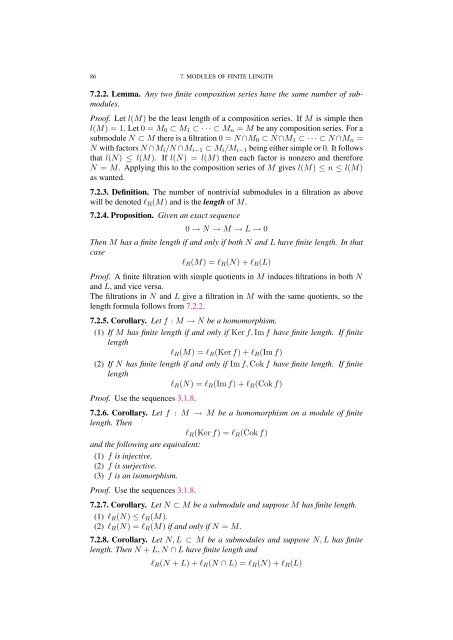Commutative algebra - Department of Mathematical Sciences - old ...
Commutative algebra - Department of Mathematical Sciences - old ...
Commutative algebra - Department of Mathematical Sciences - old ...
You also want an ePaper? Increase the reach of your titles
YUMPU automatically turns print PDFs into web optimized ePapers that Google loves.
86 7. MODULES OF FINITE LENGTH<br />
7.2.2. Lemma. Any two finite composition series have the same number <strong>of</strong> submodules.<br />
Pro<strong>of</strong>. Let l(M) be the least length <strong>of</strong> a composition series. If M is simple then<br />
l(M) = 1. Let 0 = M0 ⊂ M1 ⊂ · · · ⊂ Mn = M be any composition series. For a<br />
submodule N ⊂ M there is a filtration 0 = N ∩M0 ⊂ N ∩M1 ⊂ · · · ⊂ N ∩Mn =<br />
N with factors N ∩Mi/N ∩Mi−1 ⊂ Mi/Mi−1 being either simple or 0. It follows<br />
that l(N) ≤ l(M). If l(N) = l(M) then each factor is nonzero and therefore<br />
N = M. Applying this to the composition series <strong>of</strong> M gives l(M) ≤ n ≤ l(M)<br />
as wanted.<br />
7.2.3. Definition. The number <strong>of</strong> nontrivial submodules in a filtration as above<br />
will be denoted ℓR(M) and is the length <strong>of</strong> M.<br />
7.2.4. Proposition. Given an exact sequence<br />
0 → N → M → L → 0<br />
Then M has a finite length if and only if both N and L have finite length. In that<br />
case<br />
ℓR(M) = ℓR(N) + ℓR(L)<br />
Pro<strong>of</strong>. A finite filtration with simple quotients in M induces filtrations in both N<br />
and L, and vice versa.<br />
The filtrations in N and L give a filtration in M with the same quotients, so the<br />
length formula follows from 7.2.2.<br />
7.2.5. Corollary. Let f : M → N be a homomorphism.<br />
(1) If M has finite length if and only if Ker f, Im f have finite length. If finite<br />
length<br />
ℓR(M) = ℓR(Ker f) + ℓR(Im f)<br />
(2) If N has finite length if and only if Im f, Cok f have finite length. If finite<br />
length<br />
ℓR(N) = ℓR(Im f) + ℓR(Cok f)<br />
Pro<strong>of</strong>. Use the sequences 3.1.8.<br />
7.2.6. Corollary. Let f : M → M be a homomorphism on a module <strong>of</strong> finite<br />
length. Then<br />
ℓR(Ker f) = ℓR(Cok f)<br />
and the following are equivalent:<br />
(1) f is injective.<br />
(2) f is surjective.<br />
(3) f is an isomorphism.<br />
Pro<strong>of</strong>. Use the sequences 3.1.8.<br />
7.2.7. Corollary. Let N ⊂ M be a submodule and suppose M has finite length.<br />
(1) ℓR(N) ≤ ℓR(M).<br />
(2) ℓR(N) = ℓR(M) if and only if N = M.<br />
7.2.8. Corollary. Let N, L ⊂ M be a submodules and suppose N, L has finite<br />
length. Then N + L, N ∩ L have finite length and<br />
ℓR(N + L) + ℓR(N ∩ L) = ℓR(N) + ℓR(L)
















